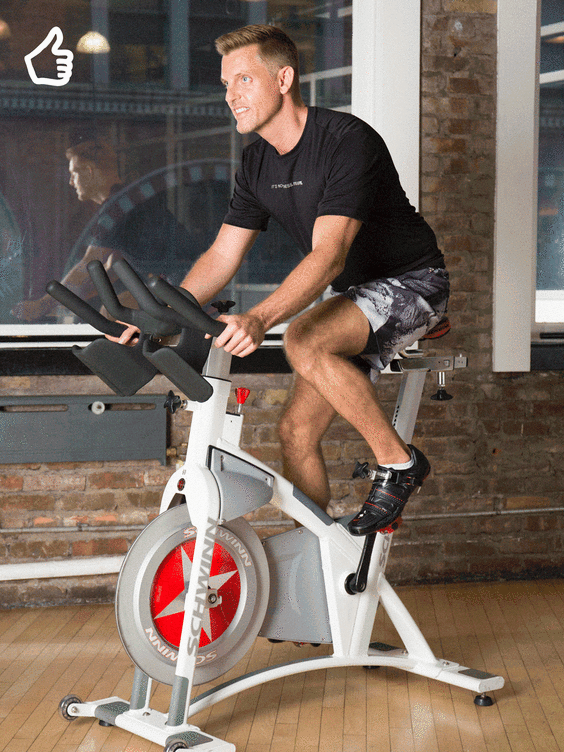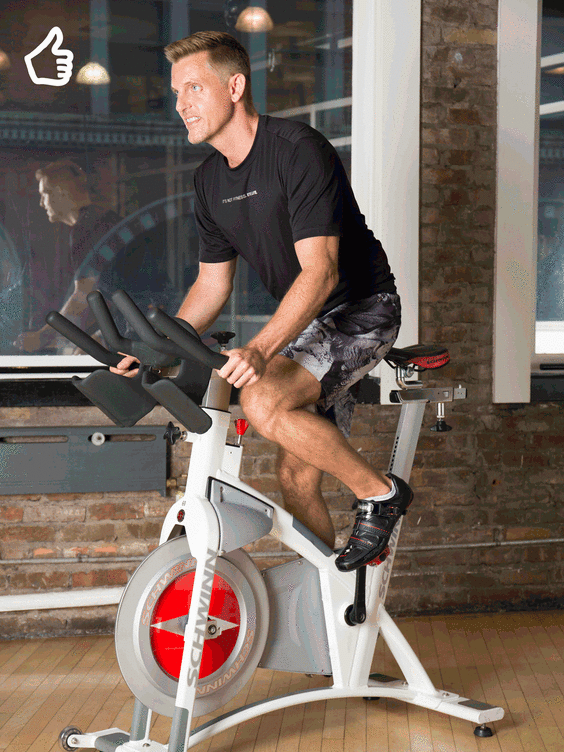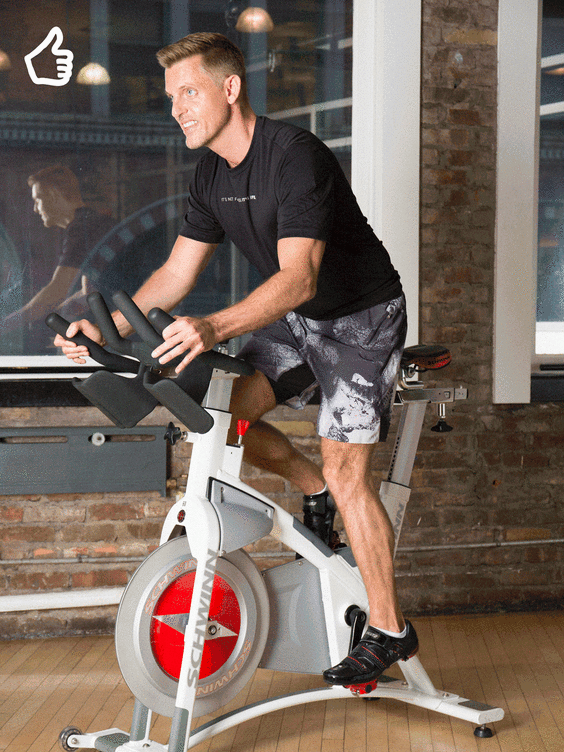You already know how to set up your bike like a pro. Now it’s time to ride like one.
We asked Wil Ashley, cycling instructor and Equinox trainer, to reenact the mistakes he frequently spots in class. Bad form doesn’t just feel weird; it can lead to a sore lower back or extra-tense shoulders. Basically, you’re not doing your body any favors.
Below Ashley demonstrates those mistakes, plus the proper way to ride in the most common positions.
There are 3 main positions that most instructors will rotate through. The outline below should be used as a general guide, since variations do exist. Master each one to ace your next class.
Position 1
Place hands where the brakes would be on a regular bike (also known as the hoods), Ashley says. As another variation, you can place hands on the middle of the handlebars. Sit on the saddle and allow torso to hinge forward naturally at hip. Engage core to keep a straight back. Relax neck and shoulders, and minimize movement in upper body.
Position 2
From position 1, rise out of saddle while keeping hands on the sides of the handlebars, close to body. Hover butt over saddle, engaging core and glutes. You should almost feel your butt brush the saddle, Ashley says.
Position 3
From position 2, bring hands forward to the ends of the handlebars. With back straight, core and glutes engaged, continue to hinge forward slightly so you can keep a natural bend in arms, and butt is back, hovering over saddle. You should feel your core, glutes, hamstrings, and quads doing the work—with no discomfort or tension in low back, neck, or shoulders.
If you find yourself making any of the mistakes below, refer back to position 1 above. And don’t forget to check in with your form throughout class. As you get tired, it’s common to relax your core, arch your back, or start compensating in other ways. The trick is to find a good balance between working up a sweat and working so hard that you can’t maintain good form. When in doubt, lower your resistance and slow down.
The Mistake: You’re all over the place in the saddle.
Your elbows are out, your back isn’t straight, and you’re hanging onto the bike like your life depends on it. It can be easy to lose good form when you get breathless and tired—but try to hang in there!Fix It: “The best advice I would tell anyone is to use common sense,” Ashley says. Would you ever walk with your back totally hunched over? Nope. Then don’t do it on the bike either. If you feel tension, strains, or stress in some part of your body as you ride, don’t push through. Take a deep breath and readjust, Ashley says.
The Mistake: You tuck your hips under when out of the saddle.
If you rise out of the saddle and tuck your hips, you immediately force your back into flexion, Ashley says. Translation: You place unnecessary pressure on your low spine (your lumbar). It’s the reason so many people often complain of a sore back after a cycling class. Fix It: Untuck your hips and send butt back to hover over the saddle.
The Mistake: You ride too far forward, like you’re leading a charge.
Yes, sometimes you just can’t wait for a class to end. But riding like you’re about to leap off your bike won’t make it happen any faster. This position, like the one above, puts unnecessary strain on your back, and if you’re on the tall side, it could cause you to hit your knees on the handlebars (ouch!). Fix It: Relax your posture and keep your hips back toward the saddle. Make sure your knees never go past the resistance knob on the bike.
The Mistake: Your toes point down, and you hunch your back.
Back pain alert! If you’re hunched over Quasimodo style, you might not be engaging your core enough. While Ashley says there are different thoughts on the exact angle your foot should be at, you don’t need to point your toes toward the ground with each rotation. Often people will sprint the flat roads with their toes, he says, and climb the hills with their heels, but you actually want to hold a more neutral foot position throughout your ride.(And yes, we’re being nitpicky here. If you’re brand new to cycling, focus on the bigger aspects of form first and fine-tune your foot position later. But it’s best not to develop bad habits early on.)Fix It: Lift your head so there’s a straight line from neck to back and think about creating perfect circles with your pedal stroke.
The Mistake: You move side to side like you’re in a music video.
We love a good dance party—just not during a bike ride. Though it can be easy to get caught up in the bumping beats of your fave songs, too much upper-body movement could cause a sore back or worse, a back injury. “If you’re following the natural movement of your body, there will be some side to side,” Ashley says. “But if you overexaggerate the movement, you may lose control, and that makes you more susceptible to injury.”Fix It: Engage core to keep weight centered over the bike and minimize bounce.
The Mistake: You put all your weight into your arms.
Push-ups are a great way to build upper-body strength, but this isn’t the place to practice. As you get tired, bearing down on your arms might feel better because you’re relieving your legs and glutes of doing some of the work. But trust us, you’re not actually doing your body any favors. Tensing your arms can lead to a sore neck, stiff shoulders, and a chain reaction of poor form through the rest of your body.Fix It: Support upper body with core so shoulders and arms can relax and hands rest lightly on handlebars.
Special thanks to Wil Ashley, cycling instructor at Equinox, who modeled for us. Ashley wears an Equinox shirt and Lululemon shorts. Shot on location at Equinox Flatiron in New York City.




